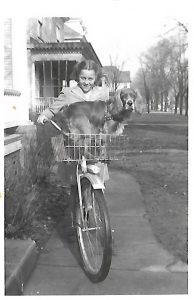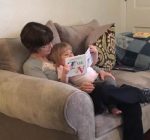
Years ago, I wrote a poem titled “How My Cousin Nancee Died.” I knew only that her husband, Steve, had shot her, and her pianist, and then himself – a double-murder-suicide. (She had a pianist because she was a singer. Her husband evidently suspected an affair.) I was sixteen when it happened, and so was Nancee’s oldest child, Penny. They lived in Ohio, but Penny had come with her grandmother, my Aunt Dorothy, to spend Christmas with us when we were twelve so we knew each other a little bit.
They visited us again after the tragedy. I remember inviting her to the drive-in with seven of my friends, all of us scrunched into my Buick station wagon. The movie was a horror flick, and I felt guilty for making her watch a film full of menace and death. She’d had enough of that, although we didn’t talk about it. I imagine my aunt sat up after the kids went to bed to talk with my dad and mom (her brother, her sister-in-law), trying to make sense of it all. Or maybe they recognized there was no sense to be made, only tears shed and comfort offered.
That was one reason I wrote the poem; I wanted to understand it. By then, I had divorced my own violet husband, who had threatened me more than once with his gun. I opened with these lines:
“Everything we knew was second-hand, / our response, long-distance.” A few lines later, I tried to set the scene:
“Years later, / in a dream, I reconstruct / that evening. The grand piano, / the lovely woman, / motes of dust / in warm yellow light, expectant.”
I thought it happened when she and her accompanist were rehearsing, in some vast music room. More lines followed: “Then silence, or shouts, / we never knew, as her husband enters. / He has a gun, and he uses it once, twice, / finally on himself.” I wondered what they said, whether he “dangled mercy / for a moment before / their startled eyes.” None of us would ever know.
Nancee was seventeen years older than me, and I hardly remember her. I heard about her talent, though. We had a painting she had made, a sparkling likeness of a freshwater fish. Her family went out in the boat, and she stayed behind to paint, showing them when they returned with their catch, “I caught one, too!” I knew she sang, but never heard her. She was a pretty child, a beautiful woman. I have the black-and-white photo albums.
When I began hunting the facts of my family tree, there was a branch missing. I could find no death record in the Social Security records for Nancy, who had long since changed her first name to Nancee and her last name to her husband’s. I knew they had many children, but could only remember a few of their names. Originally, I thought there were six, and I had to change the last line when Penny set me straight, to “Three deaths, / five orphans.” She told me they were all thriving as adults, but I could not bring myself to ask her anything more.
The other day I went back to my family tree, resuming my search for details. I knew my great-grandparents’ names and dates; I knew whom and when some of my maternal cousins had married, and the names and dates of their children. Nancee, though, remained a mystery. So I called my favorite reference librarian – my daughter, Allison, who works at the Davenport Public Library. She found it all, in record time. Not only did she send me both Nancee and Steve’s death records, she contacted the library in Ohio where the murders had taken place. And just like that, I had an article from the April 1969 Dayton Daily News.
The poem had some important details wrong. Nancee and Steve were “estranged,” the paper said. She had performed old standards at several clubs. I learned their names: The Gilded Plume. The Rhino. The Windjammer. The Pink Pussycat. The owner of one club recalled the day she walked in to audition. “She was not just good, she was great, a natural. And she always came on like the happiest girl in the world, even when things were going miserably for her.” This club owner had been beaten by her husband, after he walked her to her car following a show. He told the police, “He beat the hell out of me.” By then, I knew all about the wages of jealousy.
She worked a day job in marketing, and sang at clubs at night, all to support her children. The murder-suicide took place at the home of a musician friend who sometimes played accordion with her, when they stopped at his place for sheet music late one night. This man was not killed, as I had believed, only wounded in the right arm and left ear. He must have recounted the event for the police, but the article had no quotes from him. He’s probably gone by now, taking his secrets with him.
Fifty years after it happened, it feels like a punch in the stomach. Now I know. How many kids, how many dead, where it happened, and when. I know why, because I have been there. Not jealousy, but power and control. When I was sixteen and heard the news, it felt foreign, not only something that happened far away but something I never dreamed could happen to me. My poem counts the dead and the orphaned, then ends this way: “countless ripples on the still, wide pool / still breaking the shore.” Originally, I added two words at the end: “demanding answers.” Now I know better. What’s demanded isn’t answers, but attention, and resistance. This must not happen again.
 After retiring from a column-writing gig lasting eleven years and yielding over 300 personal essays, I find I still have something to say. My thoughts range far and wide, and occasionally deep, on subjects including being an Iowan who misses Colorado; surviving marital violence; raising an amazing daughter and an equally amazing son; being justifiably angry about the world “these days;” writing poetry and plays; wondering if I’ll get Alzheimer’s like my mom and her two brothers; wanting to write about my twin granddaughters without sounding all Hallmark-y; fixing OCD-ish food; making sense of pants that come in shorts / crops / ankle-grazing / bootcut; being a librarian in public, academic, archival, and medical libraries; waiting 46 years to attend my high school reunion; having a gorgeous garden I can’t take care of; seeing a shaman; loving good men despite all the bad ones; and trying to wrest a little joy from life despite an 11-year-and-counting chronic migraine.
After retiring from a column-writing gig lasting eleven years and yielding over 300 personal essays, I find I still have something to say. My thoughts range far and wide, and occasionally deep, on subjects including being an Iowan who misses Colorado; surviving marital violence; raising an amazing daughter and an equally amazing son; being justifiably angry about the world “these days;” writing poetry and plays; wondering if I’ll get Alzheimer’s like my mom and her two brothers; wanting to write about my twin granddaughters without sounding all Hallmark-y; fixing OCD-ish food; making sense of pants that come in shorts / crops / ankle-grazing / bootcut; being a librarian in public, academic, archival, and medical libraries; waiting 46 years to attend my high school reunion; having a gorgeous garden I can’t take care of; seeing a shaman; loving good men despite all the bad ones; and trying to wrest a little joy from life despite an 11-year-and-counting chronic migraine.
You must be logged in to post a comment.